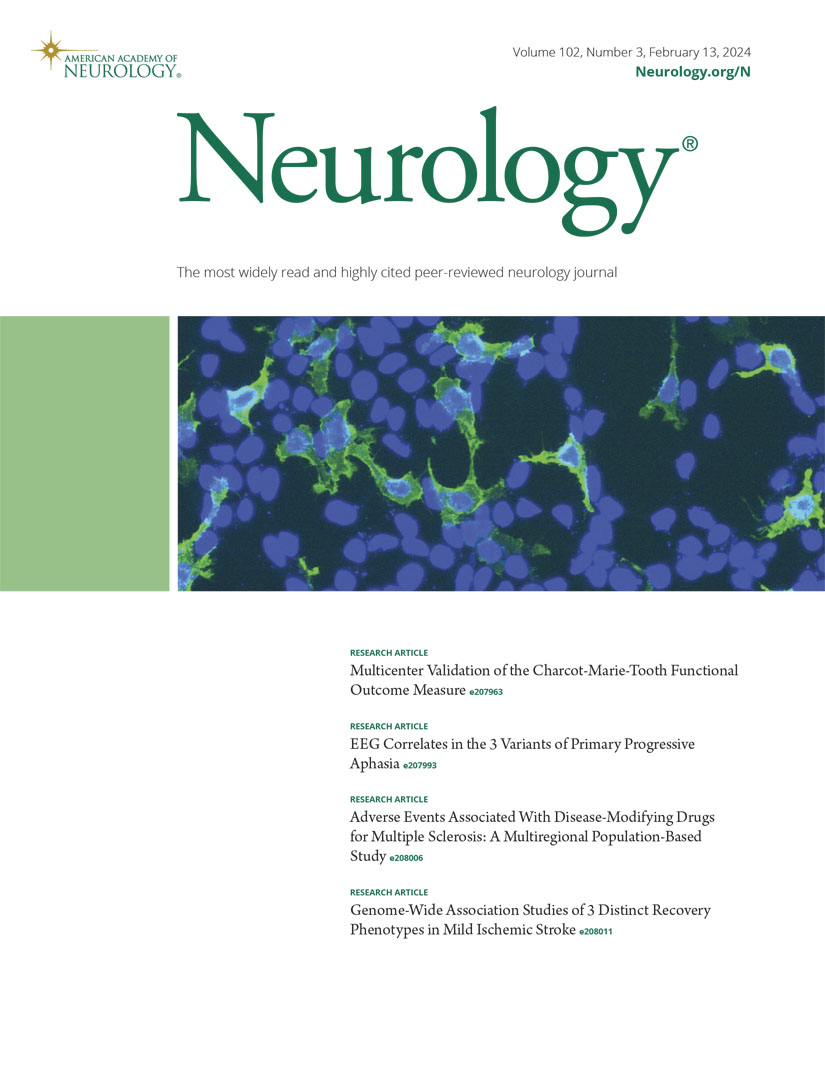Efficacy and Safety of Sodium Oxybate in Adults With Idiopathic Hypersomnia: A Randomized Controlled Trial.
IF 7.7
1区 医学
Q1 CLINICAL NEUROLOGY
引用次数: 0
Abstract
BACKGROUND AND OBJECTIVES Idiopathic hypersomnia (IH) is a rare central disorder of hypersomnolence characterized by excessive daytime sleepiness, prolonged nighttime sleep, and sleep inertia. Low-sodium oxybate is the sole Food and Drug Administration-approved treatment for IH. Objective measures of nighttime sleep and daytime sleepiness are lacking with oxybates in IH. We aimed to evaluate efficacy and safety of sodium oxybate (SXB) in IH. METHODS This phase 3, double-blind, parallel-group, placebo-controlled trial was conducted at the National Reference Center for Hypersomnia in Montpellier-France. Eligible participants aged 18-60 years with IH with an Epworth Sleepiness Scale (ESS) score ≥14 were randomly assigned to receive SXB or placebo (1:1). After a 2-week screening without any drugs and without exposure to oxybate, patients started a 6-week individual twice-nightly up-titration scheme from 4.5 g to a maximum of 9 g. Treatment was administered at stable dose for 2 weeks, followed by a 2-week taper period. The primary endpoint was the between-group difference in ESS scores at week 8, identified by a covariance analysis, including baseline ESS scores. The same methodology was applied for secondary endpoints including Idiopathic Hypersomnia Severity Scale (IHSS) score and sleep latency on the Maintenance of Wakefulness Test (MWT). Safety was examined as a secondary endpoint. RESULTS Among the 48 patients screened, 45 were randomized (36 women, 29.0 ± 7.5 years, 22 assigned to SXB, 23 to placebo) and 40 (19 receiving SXB, 21 placebo) completed the study. In the intention-to-treat analysis, the mean ESS score was significantly reduced in the SXB group compared with placebo, after adjusting for the baseline score (least squared [LS] mean difference: -6.86, 95% CI [-9.73 to -4.00]), p < 0.0001). Significant differences between SXB and placebo groups at week 8 were observed for the IHSS score (LS mean difference: -11.61; 95% CI [-16.63 to -6.59], p < 0.0001) and MWT latency (14.75; 95% CI [9.98-19.52], p < 0.0001). Treatment-emergent adverse events (nausea, headache, and dizziness) were reported in 81.8% patients with SXB and 26.1% with placebo. DISCUSSION SXB resulted in a clinically meaningful improvement in adults with IH, reducing excessive sleepiness on ESS, improving wakefulness on MWT, and decreasing IH severity on IHSS after 8 weeks. The safety profile was consistent with previous reports on SXB. TRIAL REGISTRATION INFORMATION ClinicalTrials.gov NCT03597555, EudraCT number 2017-004122-15. CLASSIFICATION OF EVIDENCE This article provides Class I evidence that sodium oxybate at a dose of 4.5-9 g per night compared with placebo reduces excessive sleepiness, improves wakefulness, and decreases disease severity with expected side effects in patients with idiopathic hypersomnia.羟酸钠治疗成人特发性嗜睡症的疗效和安全性:一项随机对照试验。
背景与目的特发性嗜睡症(idiopathic hypersleepnia, IH)是一种罕见的嗜睡中枢性疾病,其特征是白天嗜睡过度、夜间睡眠时间延长和睡眠惰性。低氧酸钠是美国食品和药物管理局批准的唯一治疗IH的方法。在IH患者中缺乏对夜间睡眠和白天嗜睡的客观测量。我们的目的是评价氧酸钠(SXB)治疗IH的疗效和安全性。方法:这项三期、双盲、平行组、安慰剂对照试验在法国蒙彼利埃的国家睡眠过度参考中心进行。年龄在18-60岁且Epworth嗜睡量表(ESS)评分≥14分的IH患者被随机分配接受SXB或安慰剂(1:1)。在没有任何药物和不暴露于氧酸盐的情况下进行2周的筛查后,患者开始了为期6周的个人每晚两次滴定方案,从4.5 g增加到最大9 g。治疗以稳定剂量给予2周,随后是2周的减量期。主要终点是第8周ESS评分的组间差异,通过协方差分析确定,包括基线ESS评分。同样的方法应用于次要终点,包括特发性嗜睡严重程度量表(IHSS)评分和维持清醒测试(MWT)的睡眠潜伏期。安全性作为次要终点进行检查。结果在筛选的48例患者中,45例随机分配(36例女性,29.0±7.5岁,22例分配给SXB, 23例分配给安慰剂)和40例(19例接受SXB, 21例安慰剂)完成了研究。在意向治疗分析中,调整基线评分后,SXB组的ESS平均评分与安慰剂相比显著降低(最小二乘[LS]平均差:-6.86,95% CI[-9.73至- 4.50]),p < 0.0001)。在第8周,SXB组和安慰剂组的IHSS评分有显著差异(LS平均差异:-11.61;95% CI [-16.63 ~ -6.59], p < 0.0001)和MWT潜伏期(14.75;95% CI [9.98 ~ 19.52], p < 0.0001)。81.8%的SXB患者和26.1%的安慰剂患者报告了治疗后出现的不良事件(恶心、头痛和头晕)。sxb对成人IH有临床意义的改善,8周后减少ESS组的过度嗜睡,改善MWT组的清醒,降低IHSS组的IH严重程度。安全概况与先前关于SXB的报告一致。临床试验注册信息clinicaltrials .gov NCT03597555,审稿号2017-004122-15。证据分类:这篇文章提供了一级证据,表明与安慰剂相比,每晚剂量为4.5- 9g的氧化钠可减少特发性嗜睡患者的过度嗜睡,改善清醒,降低疾病严重程度和预期的副作用。
本文章由计算机程序翻译,如有差异,请以英文原文为准。
求助全文
约1分钟内获得全文
求助全文
来源期刊

Neurology
医学-临床神经学
CiteScore
12.20
自引率
4.00%
发文量
1973
审稿时长
2-3 weeks
期刊介绍:
Neurology, the official journal of the American Academy of Neurology, aspires to be the premier peer-reviewed journal for clinical neurology research. Its mission is to publish exceptional peer-reviewed original research articles, editorials, and reviews to improve patient care, education, clinical research, and professionalism in neurology.
As the leading clinical neurology journal worldwide, Neurology targets physicians specializing in nervous system diseases and conditions. It aims to advance the field by presenting new basic and clinical research that influences neurological practice. The journal is a leading source of cutting-edge, peer-reviewed information for the neurology community worldwide. Editorial content includes Research, Clinical/Scientific Notes, Views, Historical Neurology, NeuroImages, Humanities, Letters, and position papers from the American Academy of Neurology. The online version is considered the definitive version, encompassing all available content.
Neurology is indexed in prestigious databases such as MEDLINE/PubMed, Embase, Scopus, Biological Abstracts®, PsycINFO®, Current Contents®, Web of Science®, CrossRef, and Google Scholar.
 求助内容:
求助内容: 应助结果提醒方式:
应助结果提醒方式:


